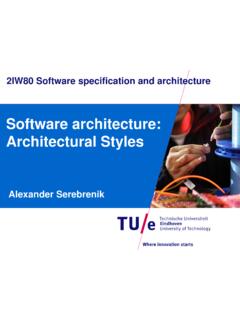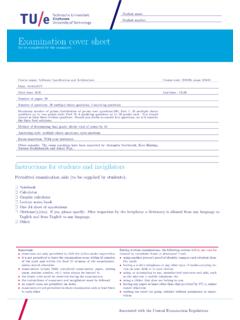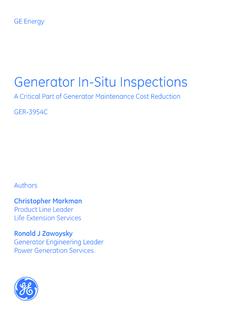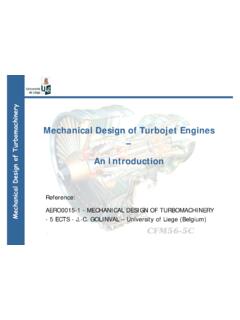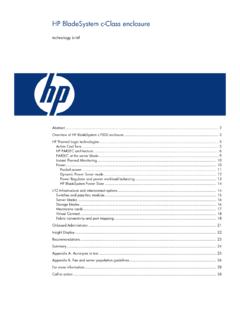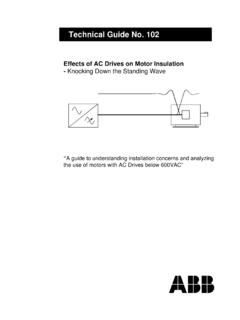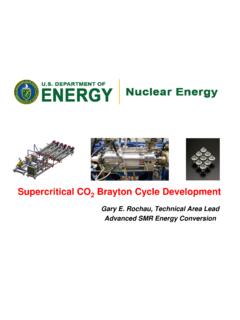Transcription of An Introduction to Acoustics - Eindhoven University of ...
1 An Introduction to Rienstra & A. HirschbergEindhoven University of Technology23 Dec 2021 This is an extended and revised edition of IWDE and corrections are gratefully file may be used and printed, but for personal or educational purposes only. Rienstra & A. Hirschberg fluid laws and constitutive equations.. and alternative forms of the conservation laws for ideal fluids..42 Wave equation, speed of sound, and acoustic of magnitude estimates.. equation for a uniform stagnant fluid and compactness.. and wave equation.. solutions.. of sound.. gas.. liquid at low frequencies.. of temperature gradient.. of mean flow.. of sound.. problem and uniqueness of sources.. and momentum injection.. s analogy.. sound.. energy.. s equation for quiescent fluids.. energy in a non-uniform flow.. energy and vortex sound..35ii Contents3 Green s functions, impedance, and evanescent s functions.. representations.
2 On finding Green s functions.. impedance.. and acoustic energy.. and reflection coefficient.. and causality.. and surface waves.. boundary condition in the presence of mean flow.. waves along an impedance wall with mean flow.. , ill-posedness, and a regularization.. waves and related behaviour.. important complex square root.. Walkman.. inverse problem.. plate pitch.. s law.. vorticity..594 One dimensional waves.. equations and method of characteristics.. wave equation.. behaviour.. simple waves and shock waves.. terms.. at discontinuities and abrupt changes.. in characteristic impedance c.. change in pipe cross section.. and high amplitude behaviour.. junction.. at a small air bubble in a pipe.. of an acoustic wave by thermal and viscous dissipation.. of a plane wave at a rigid wall.. laminar boundary layer.. in ducts with isothermal .. dimensional Green s function.. uniform tube.
3 Uniform tube.. applications.. produced by turbulence.. isolated bubble in a turbulent pipe flow.. of a wave at a temperature inhomogeneity..1025 Resonators and self-sustained oscillations, shear layers and jets.. resonators.. in duct segment.. Helmholtz resonator (quiescent fluid).. losses in a Helmholtz resonator.. Helmholtz resonator in the presence of a mean flow.. s function of a finite duct.. oscillations of a clarinet.. stability analysis.. s Criterion.. domain simulation.. thermo- Acoustics .. heat transfer by acoustic flow and Rijke tube.. induced oscillations of a Helmholtz resonator..1396 Spherical .. and translating sphere.. expansion and far field approximation.. of images and influence of walls on radiation.. s theory of jet noise.. radiation by compact bodies in free space.. Green s function.. s method.. radiation from an open pipe termination..170iv Contents7 Duct formulation.
4 Ducts.. ducts.. wall.. of complex modes.. hard-walled duct modes in uniform mean flow.. of soft-wall modes and mean flow.. expansion.. amplitudes.. fan.. and Sofrin rule for rotor-stator interaction.. source in a lined flow duct.. source in a duct wall.. duct wall.. and transmission.. discontinuity in diameter.. iris problem.. edge condition.. at an unflanged open end..2128 Approximation s horn equation.. scales.. resonator with non-linear dissipation.. varying ducts.. at an isolated turning point.. Acoustics in temperature gradient.. in shear flow.. asymptotic expansions.. junction.. line-vortices..255 Contentsv9 Effects of flow and mean flow, plane waves and edge diffraction.. or Prandtl-Glauert transformation.. waves.. diffraction problem.. point source and Doppler shift.. monopole and dipole with moving observer.. Williams & Hawkings equation for moving bodies..269 Appendix274 AIntegral laws and related transport theorem.
5 Laws.. vectors of level surfaces.. identities and theorems..276 BOrders of transforms and generalized transforms.. condition.. and group velocity.. functions.. definition.. delta function and other examples.. transforms.. dimensions and Green s functions.. distributions.. series.. Fast Fourier Transform..297 DBessel functions299 EFree field Green s functions307 FSummary of equations for fluid laws and constitutive equations.. approximation.. and isentropic.. of an inviscid non-heat conducting mean flow.. Energy Corollary.. mean flow.. harmonic.. isentropic flow.. mean flow.. mean flow..315 GAnswers to was originally the study of small pressure waves in air which can be detected by the humanear:sound. The scope of Acoustics has been extended to higher and lowerfrequencies: ultrasound andinfrasound. Structural vibrations are now often included in Acoustics . Also the perception of soundis an area of acoustical research.
6 In our present Introduction we will limit ourselves to the originaldefinition and to the propagation in fluids like air and such a case Acoustics is a part major problem of fluid dynamics is that the equations of motion are non-linear. This implies that anexact general solution of these equations is not is a first order approximation inwhich non-linear effects are neglected. In classical Acoustics the generation of sound is considered tobe a boundary condition problem. The sound generated by a loudspeaker or any unsteady movementof a solid boundary are examples of the sound generation mechanism in classical Acoustics . In thepresent course we will also include someaero-acousticprocesses of sound generation: heat transferand turbulence. Turbulence is a chaotic motion dominated bynon-linear convective forces. An accur-ate deterministic description of turbulent flows is not available. The key of the famous Lighthill theoryof sound generation by turbulence is the use of an integral equation which is much more suitable tointroducing approximations than a differential therefore discuss in some detail the useof Green s functions to derive integral to Lighthill s approach which leads to order of magnitude estimate of sound production bycomplex flows we also describe briefly the theory of vortex sound which can be used when a simpledeterministic description is available for a flow at low Machnumbers (for velocities small comparedto the speed of sound).
7 In contrast to most textbooks we have put more emphasis on duct Acoustics , both in relation to itsgeneration by pipe flows, and with respect to more advanced theory on modal expansions and approx-imation methods. This particular choice is motivated by industrial applications like aircraft enginesand gas transport course is inspired by the book of Dowling and Ffowcs Williams: Sound and Sources of Sound [55]. We also used the lecture notes of the course on aero- andhydroacoustics given by Crighton,Dowling, Ffowcs Williams, Heckl and Leppington [45].Among the literature on Acoustics the book of Pierce [183] isan excellent Introduction available for alow price from the Acoustical Society of the preparation of the lecture notes we consulted variousbooks which cover different aspects of theproblem [16, 18, 20, 40, 51, 73, 90, 96, 102, 116, 126, 153, 168, 176, 179, 227, 241].1 Some fluid Conservation laws and constitutive equationsIn fluid dynamics we consider gas and liquids as a continuum: we assume that we can define a fluidparticle which is large compared to molecular scales but small compared to the other length scalesin our problem.
8 We can describe the fluid motion by using the laws of mass, momentum and energyconservation applied to an elementary fluid particle. The integral form of the equations of conservationare given in Appendix A. Applying these laws to an infinitesimal volume element yields the equationsin differential form, which assumes that the fluid properties are continuous and that derivatives some cases we will therefore use the more general integrallaws. A conservation law in differentialform may be written as the time derivative of the density of a property plus the divergence of the fluxof this property being equal to the source per unit volume of this property in the particle [16, 176, 183,227, 241].In differential form1we have for the mass conservation: t+ ( v)=m,or t+ xi( vi)=m,( )where is the fluid density andv=(vi)is the flow velocity at positionx=(xi)and timet. Inprinciple we will consider situations where mass is conserved and so in generalm=0.
9 The masssource termmcan, however, be used as a representation for a complex process which we do not wantto describe in detail. For example, the action of a pulsatingsphere or of heat injection may be wellapproximated by such a mass source momentum conservation law is2: t( v)+ (P+ vv)=f+mv,or t( vi)+ xj(Pji+ vjvi)=fi+mvi,( )wheref=(fi)is an external force density (like the gravitational force),P=(Pij)is minus thefluid stress tensor, and the issuing mass adds momentum by an amount ofmv. In some cases one canrepresent the effect of an object like a propeller by a force densityfacting on the fluid as a source we apply equation ( ) we obtain3for ( ) v t+ P+ v v=f,or vi t+ Pji xj+ vj vi xj=fi.( )1 For convenience later we present the basic conservation laws here both in the Gibbs notation and the Cartesian tensornotation. In the latter, the summation over the values 1,2,3is understood with respect to all suffixes which appear twicein agiven term.
10 See also the appendix of [16].2 The dyadic product of two vectorsvandwis the tensorvw=(viwj).3( v)t+ ( vv)= tv+ vt+ ( v)v+ (v )v=[ t+ ( v)]v+ [vt+(v )v].21 Some fluid dynamicsThe fluid stress tensor is related to the pressurepand the viscous stress tensor =( ij)by therelationship:P=pI ,orPij=p ij ij( )whereI=( ij)is the unit tensor, and ijthe Kronecker4delta. In most of the applications whichwe consider in the sequel, we can neglect the viscous stresses. When this is not the case one usuallyassumes a relationship between and the deformation rate of the fluid element, expressed in the rate-of-strain tensor v+( v)T. It should be noted that a characteristic of a fluid is that it opposes a rateof deformation, rather than the deformation itself, as in the case of a solid. When this relation is linearthe fluid is described as Newtonian and the resulting momentum conservation equation is referred toas the Navier-Stokes equation.

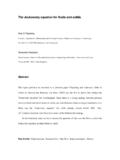

![cTRW]XbRWTd]XeTabXcTXcTX]SW^eT] Assignment 2 …](/cache/preview/d/5/c/4/6/f/6/0/thumb-d5c46f603d1ae108feb7b9bdb9fecab3.jpg)

